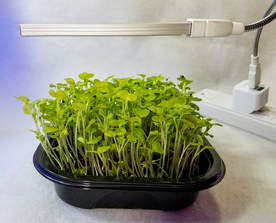 Tokyo Bekana Microgreens @ 2weeks under LED lights Tokyo Bekana Microgreens @ 2weeks under LED lights We have been following the NASA food growing experiments in space since day one. They have been fascinating to say the least and we have tried to grow some items here inspired by our space pioneers. Knowing that space travel to Mars and beyond will entail needing supplies of fresh and local produce (as in grown in space), the work becomes more than a simple experiment, but a critical part of man's journey beyond the moon. The first experiments we did were based on NASA's choice of Tokyo Bekana cabbage as the vegie to be grown, it was selected by it's fast growing traits and exceptional taste and nutrition. Microgreens inherently provide a multiple of the nutritional content of the mature vegetable and grow out in a fraction of the time, so we set out to grow some of the Tokyo Bekana in microgreen form. Our microgreens provided a dense plant material with great taste and potent nutrient content (anywhere from 4-40 times the amount vs mature vegetable). The plants shown have grown out for 2 weeks which is half the time of the recently harvested space cabbages on the ISS. Microgreens could be valuable in our race to space.  A second experiment dealt with the use of "pillows" to grow out the space vegies. We postualted that we could create such a growing system by starting with some of our hydroponic grow mats to create a similar starting system for our plants. We simply cut some slits to insert the seeds, and added a second layer below the holes. We inserted a few seeds and here is the result of our experiment which shows red cabbage at a week of growth. We hope to give you out there some ideas and inspiration. Have fun!
1 Comment
Lex
8/21/2017 09:20:36 pm
Hey, this is really cool! So, the slits keep the seeds in place in 0 gravity, then?
Reply
Leave a Reply. |
UrbaformUrbaform is a technology integrator and developer specializing in food production in the urban environment ... Archives
February 2020
Categories |




 RSS Feed
RSS Feed